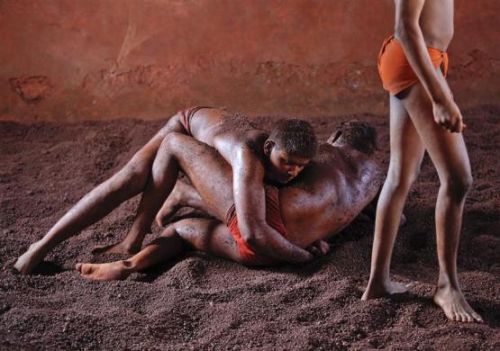
India, a country that takes pride in preserving its culture and heritage, has also been home to many local games. Most of them are being played for years, many have turned into a tradition and few are quite strange. Sometimes, the underlying concept behind the sport makes it more weird. But their weirdness serve their hallmarks and keep the audience guessing of what could happen (or could not happen) next. Eight such weird sports of India are mentioned here.
Wall of death: Maut Ka Kuan
The ‘Wall of death’ can be commonly found at the local fairs and exhibitions, particularly in rural India. The game consists of a barrel-shaped track wherein the drivers showcase their breathtaking driving skills through motorcycles and cars.
Gravitational law finds an apt application in the game. The drivers reveal curiosity in performing terrific feats like riding without hands on steering, sitting on the roof of the cars, coolly climbing out of windows and many more out of imagination acts. The weirdness is all the more aggravated by seeing multiple wheelers chasing each other at varying speeds.
The tremendous fanaticism for performing the extraordinary act can be acknowledged on actual viewing (see video).
Elepahant polo: The slower version
Elephant polo, first played during the early 1900s, is similar to horse polo. Changing horses for elephants gives a new dimension and curiosity to this game. Although, played on a smaller pitch (than horse polo), the game is slower due to colossal creatures working on the ground.
This game enjoys world-wide attraction. Certain rules are binding (like elephants cannot lie down before goals or use their trunks to pick ball) and are different from horse polo. The mahouts (professional elephant handlers) assist the players in their amazing experience.
With the players tied onto the back of their elephants, it can be really exciting watching them deliver skills through these animals.
Mallakhamb: The pole gymnastics
Mallakhamb (or Malkhamb) with origins dating back to the 12th century, is a gymnast’s feat using a vertical wooden pole. The inspiration comes from ancient art forms lacking documentation, wanting the mentors to essentially teach unique skills to their disciples.
This traditional Indian sport can be seen in various forms like Rope Mallakhamb and Hanging Mallakhamb. Gymnasts perform unique gestures hanging from hooks and chains, or clinging to poles, making the game one of its own kind. This game is played against gravity, and needs utmost concentration and rhythm. The unusual gestures performed by gymnasts speak about the tremendous combination of body movements and focused mind. The game has an international appeal and has changed somewhat with time.
Mud wrestling: Indian Kushti
Indian mud wrestling, commonly known as ‘kushti’, is an age old sport popular in rural India.
Mud plays crucially in avoiding the wrestlers from slipping (owing to sweat) in a bout. Wrestlers may also deliberately drench themselves in mud. During training sessions, a learner may perform nothing more than eating a restricted diet and sleeping, of course, wrestling in mud is inevitable throughout.
Even though this may not serve handsomely to suffice their need for money, the wrestlers must think only of aspiring towards their role model – Hanuman.
Ke Nang Haun: The pig fight
Ke Nang Huan is the famous pig fight which adorns the festival of the Nicobarese tribal people of India. In this weird game of pigs and humans, the competition is to control the perplexed pig which shoots out of a cage when smashed with an axe. The competitor can grab the ears of the pig to control it. The game is played in open spaces, allowing abundant scope for the horrified pig and its controller to chase each other.
And all the worthy effort makes the competitor the ace fighter of the Island.
Insuknawr: The rod pushing game
This ‘Mizo National Game’ in Mizoram, is played by males with round wooden rod. The one who can push his competitor out of the encircled play area (having a diameter of 15-18 ft) wins the game.
With rod under arms and properly aligned with the center of the circle, competitors cannot afford to fall or make the rod touch the ground. A hit among the males of Mizoram, the Insuknawr tests their physical strength and stamina in addition to mental acumen.
With only three to four rounds (of 60 seconds), the competitors really need to deliver their best to win the game.
Jallikattu: The bull-human fight
One of the oldest living ancient sports, Jallikattu is a part of the festivities of Tamil Nadu. In this, men (matadors) have to fight the mighty bulls. Unlike the Spanish running of the bulls, Jallikattu can turn out to be a deadly game.
The bulls are practically trained for the occasion, are wild, and the bullfighters cannot kill the bull. The bulls are made strong and sturdy, fed a nutritious diet with sharpened horns. Legends point to the game being used by women for choosing worthy husbands. Interestingly, there is a seal from the Indus Valley Civilization illustrating the sport.
Due to the risk leading to death, Jallikattu has been a controversial game. But the fascination of the players keeps it going.
Yubi Lakpi: The coconut rugby
Yubi lakpi, similar to rugby, is played using a coconut. The Manipuri game dates back to centuries, and may be the inspiration behind the modern rugby played today. It is an individual game, where the player has to present an oil soaked coconut to the ‘king’ of the event.
The barefoot player, who has to rub his body with mustard oil and water to make him slippery, is not supposed to hold the coconut against his chest but has to carry it under the arms.


